Cisterscapes
Altenberg
Welcome in the monastery landscape of Altenberg
- Filiation: Morimond
- Foundation: 1133
- Resolution: 1803
Altenberg monastery, founded directly from Morimond, is located in the Dhünn valley northeast of Cologne. Its historic cultural landscape is still well preserved today with many elements and structures. Water was of great importance as a driving force for mills and the basis for the fishing industry. The Altenberg farms were of an extraordinary size for that time and were connected to the most important trade route via the Cologne city court.
Altenberg monastery, founded directly from Morimond, is located in the Dhünn valley northeast of Cologne. Its historic cultural landscape is still well preserved today with many elements and structures. Water was of great importance as a driving force for mills and the basis for the fishing industry. The Altenberg farms were of an extraordinary size for that time and were connected to the most important trade route via the Cologne city court.
Augmented Reality - App
Explore the approximately 600 landscape and settlement traces from 17 landscapes and five countries with the Cisterscapes app. The app includes information, images and audio content on all 17 Cisterscapes sites in Europe. Based on maps, Cisterscapes elements from each monastic landscape can be selected from anywhere to learn more. Or use the augmented reality function on site to discover the Altenberg monastery landscape in 3D.
The best thing to do is to scan the appropriate QR code below or click on the button, or alternatively search for Cisterscapes in the store.
Explore the approximately 600 landscape and settlement traces from 17 landscapes and five countries with the Cisterscapes app. The app includes information, images and audio content on all 17 Cisterscapes sites in Europe. Based on maps, Cisterscapes elements from each monastic landscape can be selected from anywhere to learn more. Or use the augmented reality function on site to discover the Altenberg monastery landscape in 3D.
It's best to download the app right away using the corresponding button or, alternatively, search for Cisterscapes in the Store!




Cistercian Abbey
Altenberger Dom
Das Westfenster – größtes mittelalterliches Farbfenster nördlich der Alpen – wurde zwischen 1386 und 1397 geschaffen. Es war eine Stiftung von Herzog Wilhelm von Berg und seiner Gattin Anna von Pfalz-Bayern. Die prunkvolle Farbigkeit des Westfensters bildete eine deutliche Abkehr von der bis dahin schlichten Ausstattung der Kirche. Gezeigt ist das Himmlische Jerusalem, von unten nach oben sind abgebildet: 16 Heilige in zwei übereinanderliegenden Reihen, 8 musizierende Engel, die 4 Kirchenväter, die Gotteseltern sowie ein Christuskopf, umringt von den Zeichen des Leidensweges.
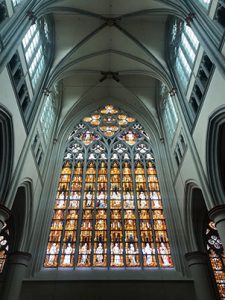
Die Plastik „Amplexus“ (1986/87) (dt. Umarmung) von Werner Franzen (1928-2014) zeigt Bernhard von Clairvaux und Martin Luther, beide Mönche und Reformer ihrer Zeit, vor dem gekreuzigten Christus. Die Figur steht im Altenberger Dom auch für die gelebte Ökumene vor Ort.
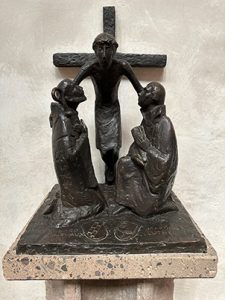
Der Altenberger Dom diente den Grafen und Herzögen von Berg bis 1524 als Grablege. Unter anderem sind hier Graf Adolf II. von Berg – Stifter des Klosters Altenberg – und sein Bruder Eberhard bestattet, der Teil des aus Morimond entsandten Konvents zur Gründung des Klosters war. Auch der letzte Herrscher aus der bergischen Linie, Herzog Wilhelm III., wurde hier mit seiner Gattin Sibylla von Brandenburg beigesetzt.
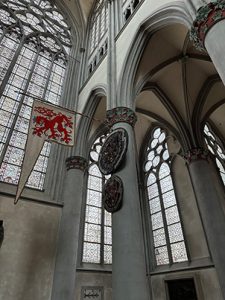
Für die Fenster des Ostchores, die noch im 13. Jahrhundert entstanden, wurde die nahezu farblose Grisailletechnik verwendet. Einzig die schönen Blattmotive schmücken die Fenster, da die strengen Ordensregeln der Zisterzieniser farbiges Glas beim Bau ihrer Kirchen zunächst untersagten.
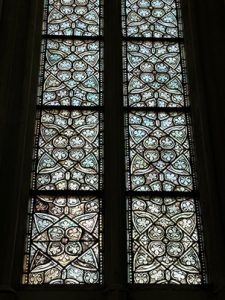
Die Orgel des Domes befindet sich im südlichen Querhaus. Sie wurde im Jahr 1980 von der Firma Klais aus Bonn eigens für den Dom gebaut und im Jahr 2005 grundlegend reorganisiert. Mit einem Bestand von 87 Registern und über 6.500 Pfeifen ist sie eine der größten Kathedralorgeln Europas.
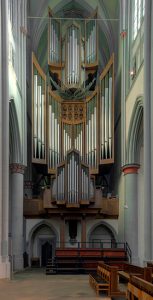
Das Denkmal vor dem Westportal des Domes wurde 1998 zum 900-jährigen Bestehen des Zisterzienserordens von Werner Franzen (1928-2014) geschaffen. Es zeigt die vier Benediktinermönche Robert von Mosleme (1028–1111), Alberich von Citeaux (1050–1109), Stephan Harding (1059–1134) und Bernhard von Clairvaux (1090–1153), die als Gründer des Zisterzienserordens gelten.
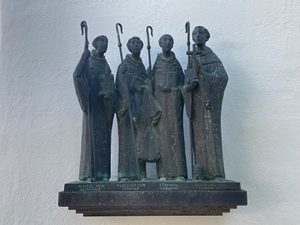
Altenberg Grange
with "Küchenhof" and Marcus Chapel
After the secularisation, the building housed various textile firms under changing owners from 1819 until a fire in 1862. Since about 1900, Altenberg grange has been an inn and has offered guest rooms. Since 1969, the farm has been managed as a family-run hotel and restaurant. It is a listed building.
An den Altenberger Hof grenzt der Küchenhof, welcher vermutlich genauso alt wie das Kloster ist.
Seine Erzeugnisse dienten der direkten Versorgung der Abtei. Er blieb bis zur
Aufhebung des Klosters im Jahr 1803 im Besitz der Zisterzienser und diente der
Eigenbewirtschaftung. Zum Küchenhof gehörten innerhalb der Mauern liegende
Wiesen und Gärten sowie Ackerland in der direkten Umgebung des Klosters. Noch
bis 1982 wurde im Küchenhof Landwirtschaft betrieben.
Old Brewery
Orangery





